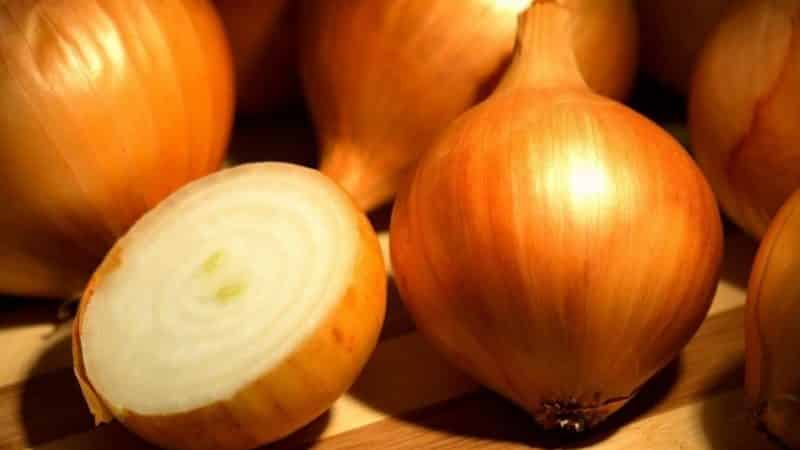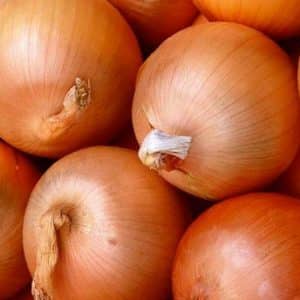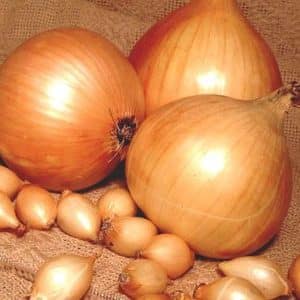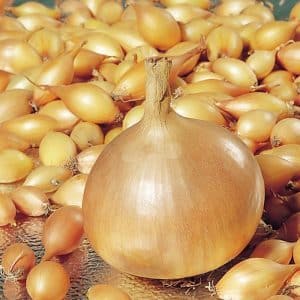Unpretentious domestically produced onion hybrid “Golden Semko”
Golden Semko is an onion hybrid created by domestic breeders. Suitable for growing from both sets and seedlings. Its main advantage is high productivity, independent of weather conditions. Vegetables are almost completely ripened before harvesting and are stored for a long time.
Description
The hybrid forms round bulbs with a thin neck, which retain a sharp and slightly spicy taste and beneficial properties for more than 7 months.

Origin and development
Golden Semko is the result of the work of domestic breeders of the Moscow company Semko-Junior. It was included in the State Register of the Russian Federation in 2000.
Composition and beneficial properties
Golden Semko onion contains:
- essential oils;
- vitamins C, PP, group B;
- phytoncides;
- potassium;
- zinc;
- iron.
The vegetable improves metabolism, has restorative and antibacterial effects, promotes the elimination of toxins, and reduces the risk of developing cancer.
Ripening time and yield
This is an early ripening hybrid: vegetables are harvested 80–90 days after germination.
Commercial yield is on average 3.3–3.5 kg/m2.
Immunity
Although Golden Semko is resistant to common diseases and pests, due to non-compliance with agricultural practices it is affected by:
- root rot;
- fusarium;
- onion flies;
- thrips;
- caterpillars.
Characteristics
The hybrid has long, about 35 cm, hollow leaves of a rich green color and single round bulbs.Turnips weigh 75–80 g, covered with 2-3 golden dry scales.
The pulp is white, dense. The aroma is characteristic of onions, the taste is pungent.
Important! The hybrid adapts well to various climatic conditions, so it is grown in all regions of the country.
Main advantages and disadvantages
Advantages of Golden Semko onion:
- high yield, independent of weather conditions;
- friendly ripening of bulbs;
- ripening up to 99% before harvesting;
- high shelf life: 95% of the crop is stored for 7 months;
- ease of care;
- resistance to drought, temperature fluctuations, diseases and pests.
Flaws:
- later ripening of the crop in the northern regions;
- short growing season of the above-ground part.
Differences from others
Comparative table of some onion hybrids:
| Hybrid | Ripening period | Productivity, kg/m2 | Bulb shape | Bulb weight, g | Taste |
| Golden Semko | Early ripening | 3,3–3,5 | Round | 75–80 | Spicy |
| Zodiac | Late ripening | 5,9 | Round | 110–300 | Sweet |
| Viking | Early ripening | 5,1 | Round | 110–250 | Sweet |
Features of planting and growing
Golden Semko is grown from seeds in an annual crop in the southern regions, from sets and through seedlings in a biennial crop in the northern and central regions.
Preparation
When growing seedlings, choose black seeds. A multi-colored shell is acceptable if the grains are treated with protective drugs.
About 10 seeds are selected 3-4 weeks before planting and germinated on a napkin. If there are at least 7 sprouted grains, the planting material is suitable for cultivation.
The seeds are soaked in water for 18 hours at a temperature of +18...+20°C, and then disinfected with a weak solution of potassium permanganate. To improve development, they are treated with growth stimulants.
The seedlings chosen are dense, 1–3 cm in diameter, without rot or mechanical damage. A few days before the start of cultivation, it is dried at +35...+40°C, and before planting in the ground, it is soaked in a solution of copper sulfate and a growth stimulator.
Important! The necks of the bulbs are not cut off so as not to interfere with the growing season of the plants.
The site has been prepared since the fall:
- dig 20–30 cm deep;
- pour a solution of copper sulfate for disinfection;
- after 7–10 days, add 3 kg of peat, 3 kg of humus, 30 g of superphosphate, 10 g of ammonium nitrate, 15 g of potassium salt and 15 g of wood ash per 1 m2;
- re-dig the ground to 30 cm.
in spring, 3-4 weeks before planting the onions, dig up the area, add 10 kg of sand, peat and 5 kg of humus per 1 m2. After this, the earth is carefully leveled, after breaking up the clods.
Soil requirements
The hybrid develops well in light, loose and fertile soil. If possible, avoid heavy clay soil and give preference to loam and sandstone.
Dates, scheme and rules of planting
In the second half of April, when 3-4 leaves are formed on the seedlings, the seedlings dive into the beds. Sowing of seedlings is carried out at the end of February:
- Mark furrows no deeper than 2 cm in a greenhouse or in containers with soil, 10 cm from the edge or leaving 5 cm between rows.
- Seeds are placed every 1.5 cm.
- Sprinkle everything with soil, compact it slightly and water it.
When growing seedlings in containers, they are covered with polyethylene and placed in a warm place with a temperature of at least +25°C. After germination, the container is transferred to a cooler place for several days, the temperature is gradually reduced to +10...+12°C.
Reference! To extend daylight hours and enhance the growth of seedlings, fluorescent lamps are used.
Picking seedlings into the ground:
- The soil in the area is leveled, and furrows no more than 5 cm deep are dug every 20–30 cm.
- Seedlings and rows are watered abundantly.
- The seedlings are removed from the containers, the roots are dipped in a mixture of mullein and clay. Seedlings are planted in furrows so that the distance between plants is 8–12 cm.
- Sprinkle everything with soil and tamp it down a little.
- The beds are mulched with peat.
Onion sets Golden Semko are planted in the spring, in early May, and in the fall, in early October. Basic condition: the soil temperature at a depth of 8–10 cm should be at least +12°C.
Scheme landings set:
- On the site, beds are prepared at a distance of 20–25 cm from each other.
- Dig furrows up to 5 cm deep.
- Place bulbs in them every 10–15 cm so that tails about 5 mm long remain above the soil surface.
Features of cultivation

The most suitable place for Golden Semko onions is the south or southeast side of the site. Choose a place that is well lit and without drafts. The permissible depth of groundwater is 1–1.5 m.
The rules of crop rotation are taken into account: the hybrid is not planted after onions and garlic; the best predecessors are cucumbers, potatoes, pumpkin, zucchini, tomatoes and cabbage.
Attention! The vegetable is capable of accumulating nitrates and pesticides, so during active growth, fertilizers are used to a minimum, adding fertilizers to the soil in advance.
Nuances of care
This is an unpretentious hybrid, the care of which consists of regular watering, fertilizing, loosening and weeding the soil.
Watering mode
Plants begin to be irrigated after germination. The first 2 months after planting, onions especially need moisture. Sprinkling is good for this. During drought, the frequency of watering is increased, and during prolonged rains, it is reduced.On average, plantings are moistened once a week.
Watering is stopped 3 weeks before harvest.
Loosening and weeding
The soil is loosened and weeded after each moistening. This will not only get rid of weeds that take nutrients from the soil, but will also provide access to oxygen and water to the bulbs and prevent the development of fungal diseases.
When watering is stopped, the soil is loosened every 5–7 days.
Feeding
During the growing season, onions are fertilized once, 2 weeks after the sprouts appear. To do this, use a compost-ash infusion: 1 kg of compost and 400 g of wood ash are diluted in 10 liters of water, left for 5 days, filtered and diluted with water in a 1:1 ratio. Consumption - 10 l per 1 m2.
Reference! Fresh manure is not suitable for cultivation: it causes an unpleasant taste in turnips.
Disease and pest control
If signs of root collar rot, fusarium or other diseases are detected, the plantings and soil are sprayed with a 1% solution of copper sulfate, and after 10 days they are dusted with wood ash.
To prevent the crop from being affected by diseases, they follow the rules of crop rotation, watering regime, and monitor the density of plantings, the level of humidity and temperature. After harvesting, all plant debris is removed.
When pests onions are treated with insecticides: “Aktellik”, “Aktara” and others.
Harvest and storage
The main signs of ripeness of vegetables are lodging of leaves and drying of the neck of the bulbs.
Turnips are collected in the second half of July, on a clear, dry day, carefully pulling them out of the ground by their feathers.
Storage features and shelf life
The harvested crop is carefully inspected and sorted, rotten and spoiled vegetables are removed. A specimen with mechanical damage is put aside for immediate attention. use.
The onions are laid out in the sun or under a canopy for about 2 weeks so that they dry well. Then they are placed in nets or wooden boxes and taken out to a dark, well-ventilated room with a temperature of +2...+10°C.
In the right conditions, Golden Semko is stored for a long time: after 7 months, only 5% of the crop spoils.
Difficulties in growing
The main problems when cultivating a hybrid:
- low yields or small turnips are the result of violation of crop rotation rules, planting in acidified or too heavy soil;
- premature drying and yellowing of leaves indicates a lack of moisture;
- the bulbs do not fully ripen by the time of harvest due to excessive watering and constant fertilizing;
- pale and thin leaves indicate a lack of nitrogen-containing fertilizers, and wilting and blackening of the tops of the foliage indicate a deficiency of fluoride.
Advice from gardeners
Experienced gardeners recommend:
- Divide the sets by size: up to 5–8 mm in diameter, 8–18 mm and up to 25 mm. Bulbs of different sizes require different care. The optimal size is 15–25 mm.
- Plant the bulbs at a medium depth to prevent them from growing too elongated and becoming deformed.
- Do not neglect the disinfection of seed material: this will reduce the risk of developing diseases.
Reviews
Reviews about the hybrid Golden Semko are mostly positive.
Vladimir, Tula: «I studied the descriptions of many varieties and hybrids - the Golden Semko onion caught my attention and tried to plant it. I liked his ability to adapt to weather conditions. There is no need to be afraid of slight temperature fluctuations: this will not affect the harvest. Other advantages of the hybrid are high productivity and long-term storage.”
Maria, Kazan: “Our family loves onions: we eat them fresh and add them to various dishes. At the same time, I haven’t grown it myself before, but a year ago my godfather shared seedlings, and I decided to try it. The debut turned out to be successful: the harvest was rich, the turnips were beautiful and strong, the crop needed minimal care.”
Conclusion
Golden Semko is an unpretentious onion hybrid that adapts well to any climatic conditions and weather changes, and is suitable for cultivation in all regions of Russia. The crop consistently produces high yields and, with proper care, is resistant to diseases and pests. The pungent, slightly spicy onions are versatile in cooking and can be stored for more than 7 months.